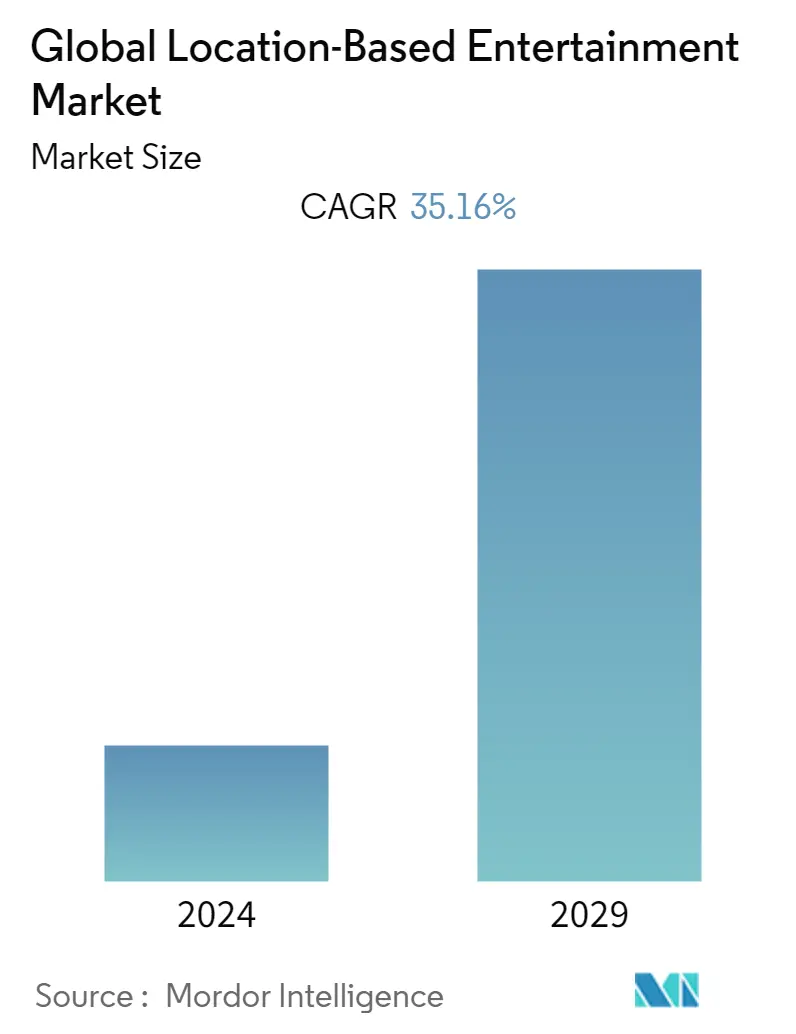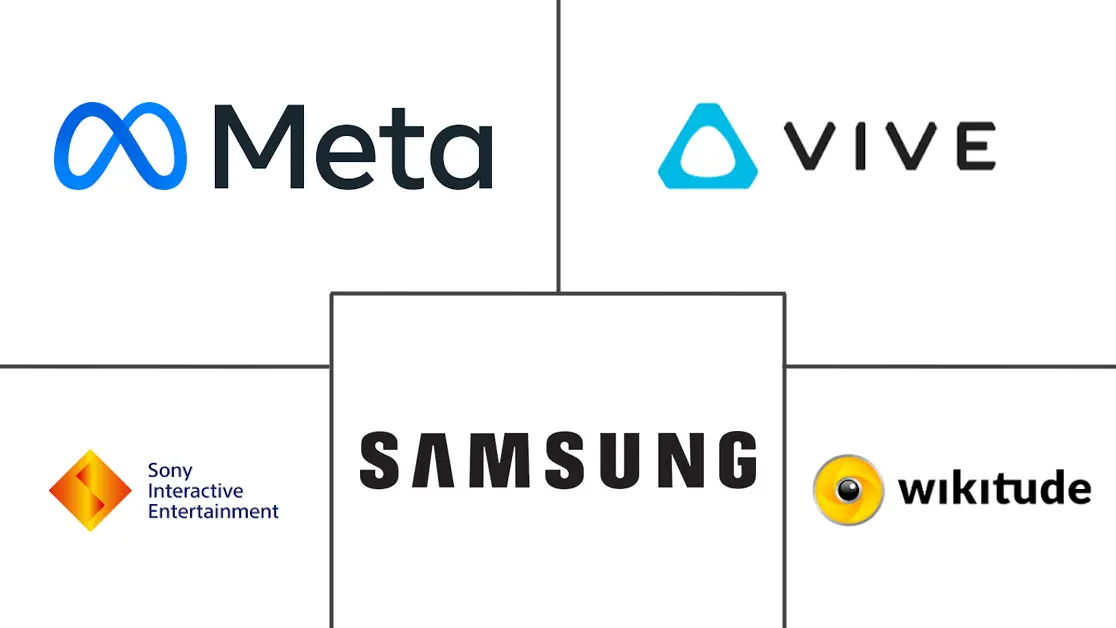Market Size of Global Location-Based Entertainment Industry

| Study Period | 2019 - 2029 |
| Base Year For Estimation | 2023 |
| CAGR | 35.16 % |
| Fastest Growing Market | Asia-Pacific |
| Largest Market | North America |
| Market Concentration | Medium |
Major Players
*Disclaimer: Major Players sorted in no particular order |
Location-Based Entertainment Market Analysis
The Global Location-Based Entertainment Market is expected to register a CAGR of 35.16% over the forecast period (2022-2027). The location-based entertainment (LBE) industry is driven by rising demand from the end-user sectors of theme parks, arcade studios, and movie theaters due to improved content with technology adoption.
- The gaming business is going through a paradigm transition, and the established players in the market are eager to pursue technology-driven projects. Customers are thought to be embracing virtual reality (VR) in large numbers, particularly considering the industry's focus on multiplayer games. The trend, in turn, drives smaller businesses to participate in the LBE sector, fueling the market's expansion.
- Moreover, several governments are supporting location-based entertainment. For instance, the ITA report mentioned that the United States government supports location-based entertainment (LBE) and themed attractions by exporting items to construct amusement parks and associated interests. Support for various service models, including franchise, public, and private experience-driven activities, is part of this. Individuals, businesses, and consortiums with at least 51% U.S. content may ask for international assistance for LBE services.
- Significant players, such as Reality Labs in Meta, HTC VIVE, Sony Interactive Environment, etc., are investing much in research and development to introduce simulation technologies. Due to customers' evolving preferences for out-of-home entertainment, businesses are looking into several initiatives to offer more engaging ways to use shared social spaces and integrate people.
- The rising population spending on outdoor activities and the use of 3D technology at entertainment locations offering a realistic experience are the primary drivers of the market. The high expense of creating the content makes it a difficult challenge for market participants.
- The COVID-19 pandemic outbreak has negatively impacted market conditions. As part of the lockdowns implemented in many countries to prevent the spread of coronavirus, several LBE facilities, such as amusement parks, theme parks, arcades, and theatres, were temporarily shuttered. To gain traction and draw a sizable audience in the post-pandemic era, these LBE centers can now make the most of their limited resources by engaging customers, providing them with compelling reasons to return, educating customers about best practices to reduce health risks, and implementing data analytics to address customer needs.
Location-Based Entertainment Industry Segmentation
The Global Location-Based Entertainment Market is Segmented By Type (Hardware, Software), By Application (Arcade, Theme Parks, Cinemas), and Geography.
| By Type | |
| Hardware (Headsets) | |
| Software |
| By Application | |
| Arcades | |
| Theme Parks | |
| Cinemas |
| By Geography | |
| United States | |
| Europe | |
| China | |
| Rest of the World |
Global Location-Based Entertainment Market Size Summary
The global location-based entertainment (LBE) market is experiencing significant growth, driven by increased demand from sectors such as theme parks, arcade studios, and movie theaters. This growth is largely attributed to the integration of advanced technologies like virtual reality, which is gaining popularity among consumers, especially in multiplayer gaming. The market is further bolstered by government support in various regions, including the United States, which promotes the export of amusement park infrastructure and related services. Major industry players, such as Reality Labs in Meta, HTC VIVE, and Sony Interactive Environment, are heavily investing in research and development to enhance simulation technologies, aiming to create more engaging out-of-home entertainment experiences. Despite the challenges posed by high content creation costs and the impact of the COVID-19 pandemic, which temporarily closed many LBE facilities, the market is poised for recovery and expansion as these centers adapt to post-pandemic consumer preferences.
Regionally, the Asia Pacific is expected to witness the fastest growth in the LBE market, driven by a shift towards outdoor recreational activities and the presence of numerous VR hardware and software vendors. Countries like China, Japan, South Korea, and India are seeing a rise in VR game players, further propelling market expansion. In North America, the market remains dominant due to the rapid adoption of location-based VR technologies and the presence of major suppliers. The region's media and entertainment sectors are also contributing to this dominance. The global LBE market is moderately consolidated, with key players like Oculus by Meta, HTC VIVE, and Sony Interactive Entertainment holding significant market shares. These companies are expanding their international consumer bases and advancing technologies such as AR and VR to enhance profitability and market presence.
Global Location-Based Entertainment Market Size - Table of Contents
-
1. MARKET INSIGHTS
-
1.1 Market Overview
-
1.2 Industry Attractiveness - Porter's Five Forces Analysis
-
1.2.1 Bargaining Power of Suppliers
-
1.2.2 Bargaining Power of Buyers/Consumers
-
1.2.3 Threat of New Entrants
-
1.2.4 Threat of Substitute Products
-
1.2.5 Intensity of Competitive Rivalry
-
-
1.3 Industry Ecosystem Analysis (Hardware| Software & App Development| Content Creators| Service Providers| End-users| Network Providers)
-
-
2. MARKET SEGMENTATION
-
2.1 By Type
-
2.1.1 Hardware (Headsets)
-
2.1.2 Software
-
-
2.2 By Application
-
2.2.1 Arcades
-
2.2.2 Theme Parks
-
2.2.3 Cinemas
-
-
2.3 By Geography
-
2.3.1 United States
-
2.3.2 Europe
-
2.3.3 China
-
2.3.4 Rest of the World
-
-
Global Location-Based Entertainment Market Size FAQs
What is the current Global Location-Based Entertainment Market size?
The Global Location-Based Entertainment Market is projected to register a CAGR of 35.16% during the forecast period (2024-2029)
Who are the key players in Global Location-Based Entertainment Market?
Meta, HTC, Samsung Electronics Co., Ltd., Sony Interactive Entertainment Inc. and Wikitude are the major companies operating in the Global Location-Based Entertainment Market.

